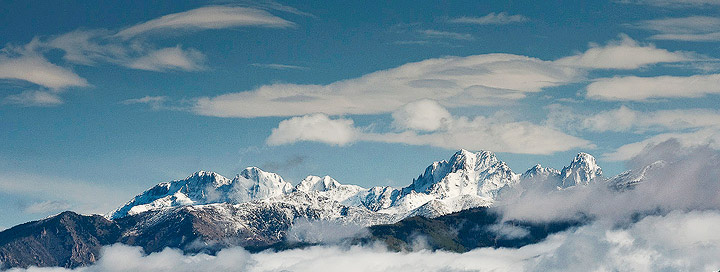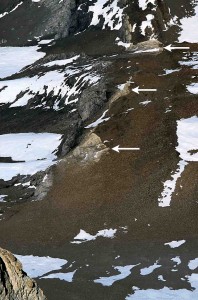Neoproterozoic to Cambrian Strata of Central Transantarctic Mountains
Photo: Large, light-colored archeocyathan reefs (white arrows), thens of meters thicks, in the Lower Cambrian Shackleton Formation, Holyoake Range, Antarctica. Bedding is vertical and stratigraphic up is to right. Reefs are surrounded by shale, nodular carbonate and shale, and fine-grained sandstone. These coarsen upwards into alluvial fan conglomerate. The drowning of the reef and the progradation of an alluvial fan complex is the record of the initial active tectonic stage of the Ross Orogeny.Work done with John Goodge (U. of Minnesota, Duluth) in 1999 and 2000 resulted in a number of publications that covered aspects of sedimentology, stratigraphy, structural geology, thermochronology, and detrital zircon geochronology. Our detrital zircon data suggested that there was an extension of the Laurentian 1.4 Ga anorogenic belt of granitic intrusive bodies that exists under the ice in Antarctica. Goodge et al. (2008) provided strong evidence for this idea in the form of a granitic boulder of similar age and chemistry from modern till, cementing the hypothesis of a Laurentian–Antarctic connection within the supercontinent Rodinia.
I returned to Antarctica in 2012, working with Lars Holmer (Sweden) and colleagues (Glen Brock, Lars Stemmerik, and Christian Skovsted). This work is a more detailed paleontological study of Lower Cambrian strata.
Publications:
Goodge, J.W., Vervoort, J.D., Fanning, C.M., Brecke, D.M., Farmer, G.L., Williams, I.S., Myrow, P.M., and DePaolo, D.J., 2008, A positive test of East Antarctic–Laurentia juxtaposition within the Rodinia supercontinent: Science, v. 321, p. 235-240.
Goodge, J.W., Williams, I.S., and Myrow, P.M., 2004, Provenance of Neoproterozoic and lower Paleozoic siliciclastic rocks of the central Ross Orogen, Antarctica: Detrital record of rift- to active-margin sedimentation: Geological Society of America Bulletin, v. 116, p. 1253-1279.
Goodge, J.W., Myrow, P.M., Phillips, D., Fanning, C.M., and Williams, I.S., 2004, Siliciclastic record of rapid denudation in response to convergent-margin orogenesis, Ross Orogen, Antarctica, in Bernet, M., and Spiegel, C., eds., Detrital Thermochronology — Provenance analysis, exhumation, and landscape evolution in mountain belts: Geological Society of America Special Paper 378, Boulder, Colorado, p. 101-122.
Goodge, J.W., Myrow, P.M., Williams, I.S., and Bowring, S., 2002, Age and provenance of the Beardmore Group, Antarctica: constraints on Rodinia supercontinent breakup: Journal of Geology, v. 110, p. 393-406.
Myrow, P.M., Fischer, W., and Goodge, J.W., 2002, Wave-modified turbidites: combined-flow shoreline and shelf deposits, Cambrian, Central Transantarctic Mountains: Journal of Sedimentary Research, v. 72, p. 641-656.
Myrow, P.M., Pope, M., Goodge, J.W., and Fischer, W, 2002, Depositional history of pre-Devonian strata and timing of Ross Orogenic tectonism in the central Transantarctic Mountains: Geological Society of America Bulletin, v. 114, p. 1070-1088.

